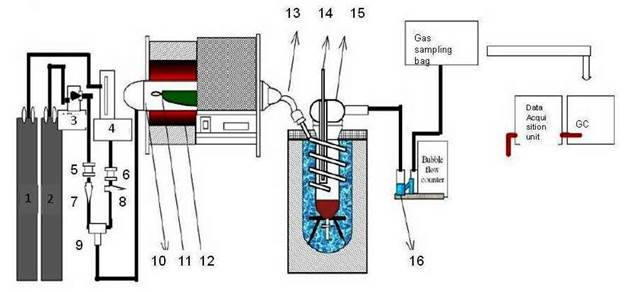|
Catalytic conversion of
microalgae for biofuel production
Microalgae are aquatic
biomass that grows naturally in salt and fresh
water. Cultivation of microalgae has gained a
lot of attention due to its high growth yield,
cultivation in saline and fresh water and carbon
dioxide efficiency. These algal cultivation
properties make it one of the most sustainable
sources of biomass when compared to terrestrial
biomass such as forest biomass and cultivated
crops.
Biomass conversion processes
are classified into three major groups,
biochemical, thermo chemical and chemical
separation.
My research focuses on pyrolysis and
catalytic cracking of microalgae which has an
added advantage over other thermochemical
conversion processes, such as gasification,
direct combustion and liquefaction. Pyrolysis
and catalytic cracking has an established simple
process that occurs at relatively mild
conditions.
This research will
investigate the effect of temperature and
catalysts on the yield and physico-chemical
properties of the biofuel product (bio-oil,
biochar and biogas) on pyrolysis and catalytic
cracking of microalgae (Chlorella vulgaris and
Nannochloropsis oculata). The experiment will be
carried out in a fixed bed reactor in a helium
flow with a rapid cooling of condensable
volatiles in a dewar flask containing dry ice as
shown in Figure 1.
Thermogravimetric studies of
samples used in pyrolysis and catalytic cracking
as well as the bio-oil products will be carried
out using a simultaneous thermogravimetric
analyser (TGA-DSC) to determine the pyrolytic
characteristic and thermogravimetric parameters.

Fig 1 - Schematic
diagram of experimental set-up
(1. Air bottle 2. Helium
Bottle 3. Flow meter 4. Rotameter 5 & 6.1/8
check valves 7 & 8. One way valves 9. 1/8 Union
tee10. Reactor 11. Sample boat 12. Furnace13.
Connection joint 14. Thermocouple 15. Coiled
condensing trap 16. De-ionized)
For
more details please contact
Prof. Adam Harvey
or
Dr Jonathan Lee.
|